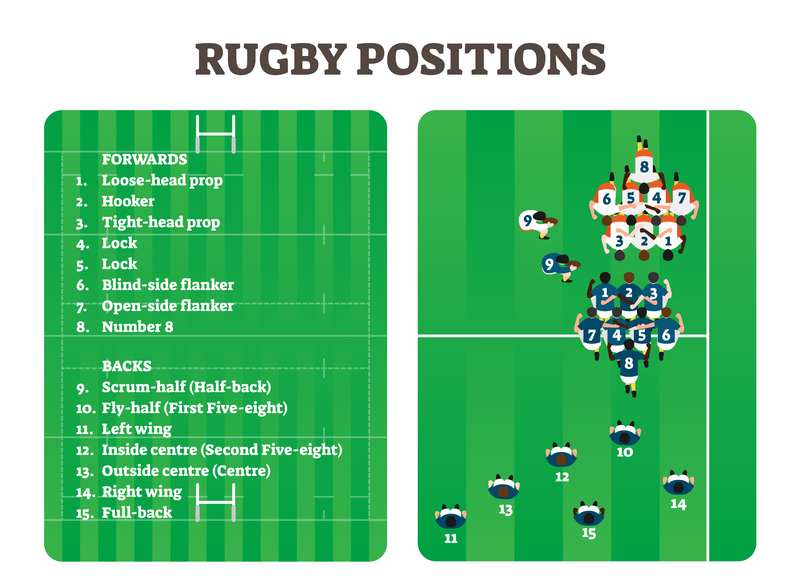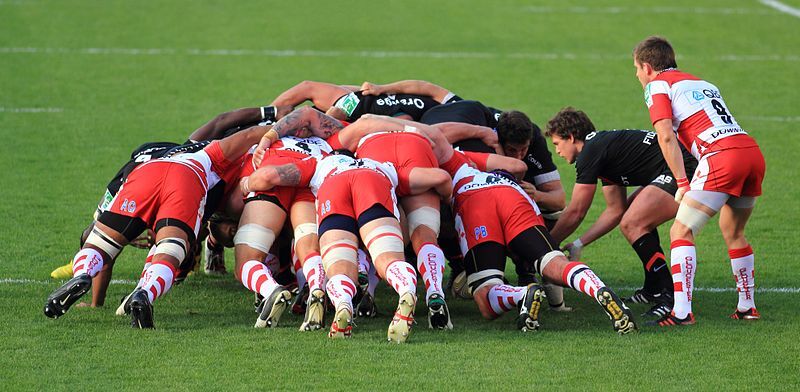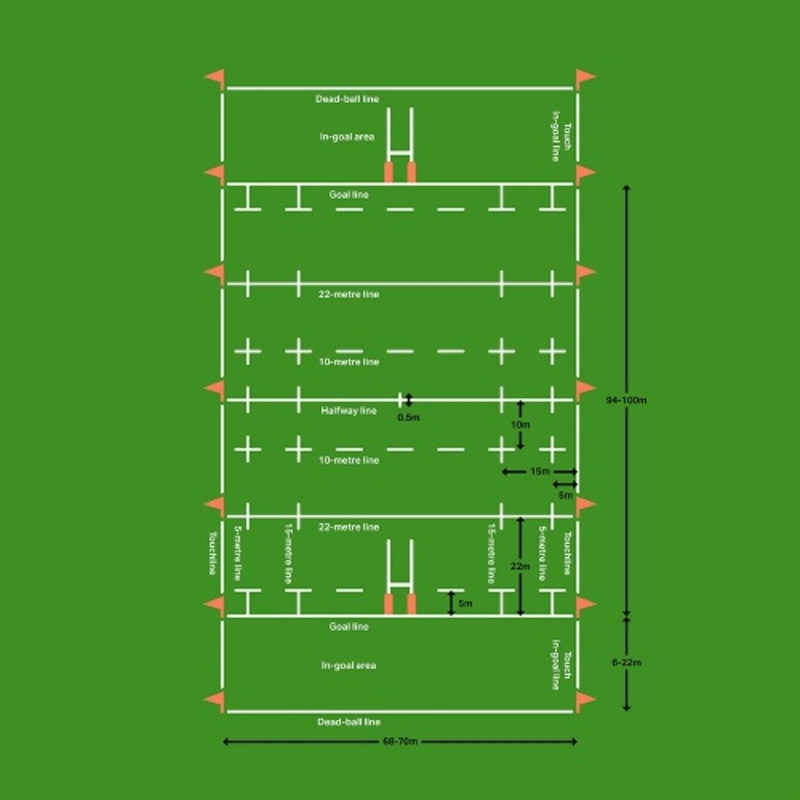Let's get into Rugby: A Guide to the Rules, Scoring, and Positions of Rugby Union

An introduction to rugby
Get ready to scrum down and ruck, because we're diving into the exhilarating world of rugby! Rugby is a sport that is beloved by fans all around the world, with its hard-hitting tackles, exciting plays, and intense competition. It is a physically demanding sport that requires strength, endurance, and skill. To play the game, it is important to understand the rules that govern it. In this article, we'll take a look at the rules of rugby, including player positions, traits, the pitch, scoring, and the difference between rugby union and rugby league.
Rugby is played by tough, dedicated, and passionate athletes from around the world. It is a game of speed, strength, and strategy, where players must work together to overcome their opponents and score points. The sport is played on a rectangular field and features two teams of 15 players each. The objective of the game is simple - carry, pass, and kick an oval-shaped ball over the opposing team's goal line to score points. With its combination of physicality, athleticism, and teamwork, rugby is a sport like no other, and one that captures the hearts and minds of fans and players alike.
Try Sportmember for free - Create profile
Rugby positions and player traits
Rugby is a game that requires a diverse set of skills and abilities from its players. There are fifteen players on each team, split into two groups - forwards and backs. Here's a breakdown of the different player positions:
Forwards:
- Props: Powerful and strong, props are essential for winning the scrum battle.
- Hookers: Known for their accuracy in the lineout, hookers are also responsible for the throw-ins.
- Locks: Tall and strong, locks are crucial in the scrum and lineout.
- Flankers: Agile and quick, flankers are essential for disrupting the opposition and securing turnovers.
- Number 8: The last player in the scrum, the number 8 is responsible for providing the platform for the backline.
Backs:
- Scrum-half: The link between the forwards and backs, the scrum-half is responsible for passing the ball out of the scrum.
- Fly-half: The playmaker of the team, the fly-half is responsible for making strategic plays and kicking.
- Centres: The midfielders of the team, the centres are responsible for breaking through the opposition's defence.
- Wingers: The fastest players on the team, wingers are responsible for scoring tries.
- Fullback: The last line of defence, the fullback is responsible for catching high kicks and returning them.

Rugby union rules and different game elements
Rugby union has different core elements that make up the gameplay. The objective of the game is to score more points than the opposing team by carrying, passing, and kicking an oval-shaped ball over your opponent's goal line.
The game begins with a kickoff, after which both teams try to gain possession of the ball. Possession can be gained by either winning a scrum or a lineout, or by stealing the ball from the opposing team through a tackle or a ruck.
Once a team has possession of the ball, they can carry it forward by running with it or passing it laterally or backwards to a teammate. You can't pass the ball forwards. You can kick the ball forward to gain territory or to try to score points through a drop goal or if a team is awarded a penalty.
- The Tackle. The tackle is one of the key elements of rugby union. It's when one player takes down another player, but the tackled player must immediately release the ball and the player with the ball must also release it.
- The Ruck. The ruck is a fun part of the game that happens when a tackle is made, the ball is on the ground, and both teams are competing for it. The ball can't be handled, but players use their strength to try and push over the ball to try and win possession. It's like a big controlled aggressive dance-off, but with a ball.
- The Scrum. The scrum is a set piece to restart the game. It takes place when a stoppage happens because of a minor infringement in the rules (e.g. a forward pass or the ball being knocked forward out of the hands, also known as a "knock-on") or the ball becoming unplayable in a ruck or maul. It's made up of eight players from each team who bind together and try to push the opposition backwards. Then, the scrum half feeds the ball into the scrum to restart play.
- The Lineout. The lineout is another set piece that happens when the ball goes out of play over the touchline. Both teams form two lines, typically with their forwards, and attempt to win the ball, usually thrown in by the hooker.
- Offside. Offsides occur when a player is closer to the opponent's goal line than the ball and the player who last played the ball. An offside player can't play the ball or interfere with play.

The rugby pitch
A rugby pitch is a rectangular field that measures 94-100 meters long by 68-70 meters wide. The pitch is split into two halves, with each half containing a try line, a dead-ball line, and an in-goal area (or try-scoring area). The area between the two try lines is known as the field of play.

Scoring points in rugby
Scoring in rugby union is the best part, right? There are four ways to score points - by scoring a try, conversion, penalty kick, or drop goal. The aim of the game is to score as many points as possible by either scoring a try or kicking the ball over the opposition's crossbar. Here's a breakdown of the scoring system:
- Try: 5 points. A try is when a player touches the ball down in the opposition's goal area.
- Conversion: 2 points. A conversion is when the team scores additional points by kicking the ball from the ground (or often off of a small tee) between the goalposts after a try.
- Penalty kick: 3 points. A penalty kick is awarded when the opposition has infringed, and a penalty is awarded. A team can choose to kick for the goal and score points by kicking the ball between the goalposts from the ground where the infringement took place (often using a small tee).
- Drop goal: 3 points. A drop goal is when the ball is kicked over the crossbar and between the goalposts, from open play. The ball must first drop from the hands and touch the ground before being kicked. This is why it's called a drop goal.
Who runs rugby union - Governing Bodies
World Rugby
Previously the IRB (International Rugby Board), now known as World Rugby, is the governing body of rugby union worldwide. World Rugby is responsible for setting and enforcing the rules of the game, as well as organizing international competitions, such as the rugby world cup.
Rugby union governing bodies in the UK
In the UK, rugby union is governed by the Rugby Football Union (RFU) in England, the Scottish Rugby Union (SRU) in Scotland, the Welsh Rugby Union (WRU) in Wales, and the Irish Rugby Football Union (IRFU) in Ireland. Each of these governing bodies is responsible for overseeing the game at a national level, including organizing domestic competitions and promoting the sport in their respective countries.
Rugby league vs Rugby union
Rugby league and rugby union are often compared and confused as the same sport, but they are actually two different sports with their own unique set of rules and playing styles.
- The number of players: The number of players on the field is a key difference. Rugby union has 15 players per team, while rugby league has 13. This affects the playing style and strategy of each sport.
- Different gameplay: The breakdown, or where players can compete for the ball, is also different. In rugby union, players can compete for the ball on the ground in a ruck or a maul, and there are no limits to the number of phases this can happen. In rugby league, the tackled player must be released, and then release the ball between the legs, and play is restarted with a teammate tapping the ball with their foot, before running and/or passing. In rugby league, each team also only has 5 tackles to gain metres, before the opposition is given possession - often by receiving a kick, or by making a 6th tackle.
- Different scoring: There are also differences in the scoring system. In rugby union, a try is worth 5 points, and a conversion is worth 2 points, with penalty kicks and drop goals also contributing to the score. In rugby league, a try is worth 4 points, with a conversion worth 2 points, and penalty kicks (2 points) and drop goals (1 point) also contribute to the score.
- Different games, with the same shape ball: Despite the similarities, rugby league and rugby union are two distinct sports with their own unique cultures and communities. Each sport has its own set of rules, playing style, and strategy, and they should not be mistaken for one another.
Rugby union culture and values
Rugby union has a unique culture and set of values that are cherished by its players and fans around the world. One of the key values in rugby is respect – respect for your teammates, your opponents, and the referees. This value is evident on the field, where players often help each other up and congratulate each other after a hard-fought game.
Another important value in rugby is teamwork. Rugby is a team sport that requires all 15 players to work together and support each other to achieve success. This teamwork is built on a foundation of trust, as each player relies on their teammates to execute their roles on the field.
Rugby is also known for its camaraderie and sense of community. Rugby players often form close bonds with their teammates and opponents, and the sport has a strong social aspect with post-game gatherings and events.
The rugby community is also known for its inclusivity and diversity. Rugby is a sport that welcomes players of all shapes, sizes, and backgrounds, and there are many initiatives to increase participation from traditionally underrepresented groups.
In rugby, the values of respect, teamwork, camaraderie, and inclusivity are not just words – they are lived and breathed by its players and fans. It is these values that make rugby such a special and beloved sport around the world.
Rugby union and SportMember
Rugby is a sport that is both physically and mentally challenging, requiring a wide range of skills and abilities from its players. With its exciting gameplay and rich history, it's no wonder that rugby has become a beloved sport all around the world. Whether you're a seasoned fan or a newcomer to the sport, understanding the rules of rugby is key to fully appreciating this thrilling game.
The full overview and laws of the game can be found on the World Rugby website. There are thousands of rugby clubs in the UK, and many of them are using a club management system, like Sportmember, to streamline their club admin and help save time running their club.
SportMember allows you to gather all the club's functions in one place; member database, calendar and event planning, attendance, membership fees collection, and so much more (including a fully integrated and free website).
Creating a club profile on SportMember will help you run and structure the club, and save you a lot of time on otherwise manual tasks. Try it out by clicking "Create profile" below.